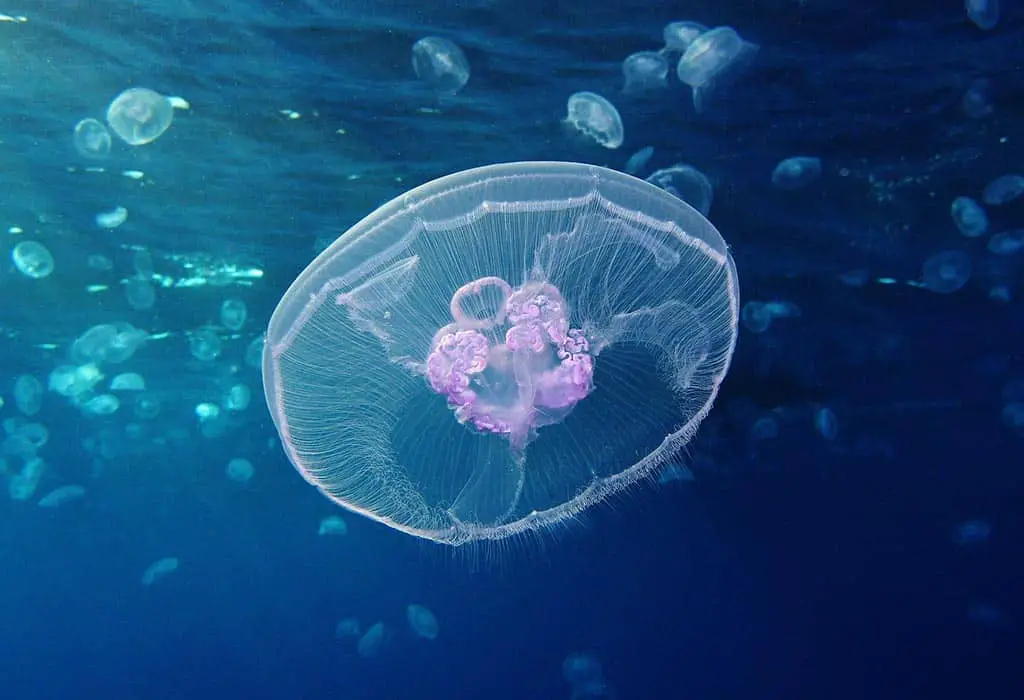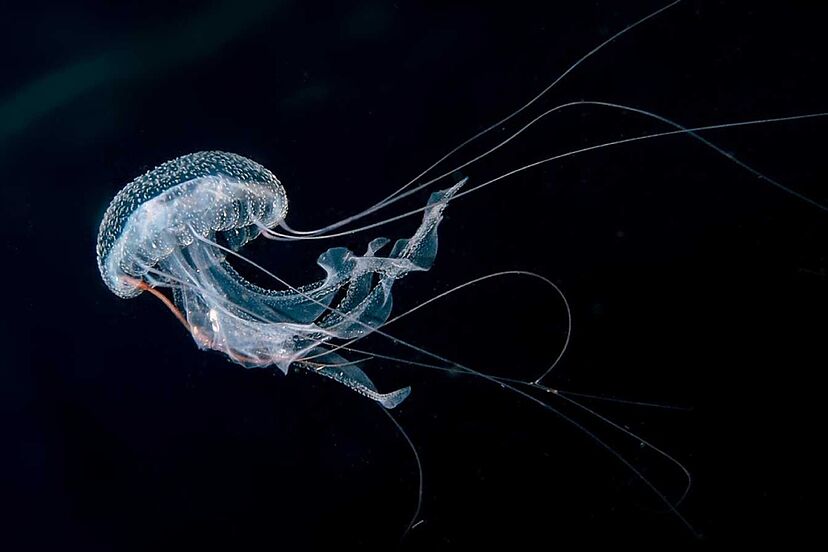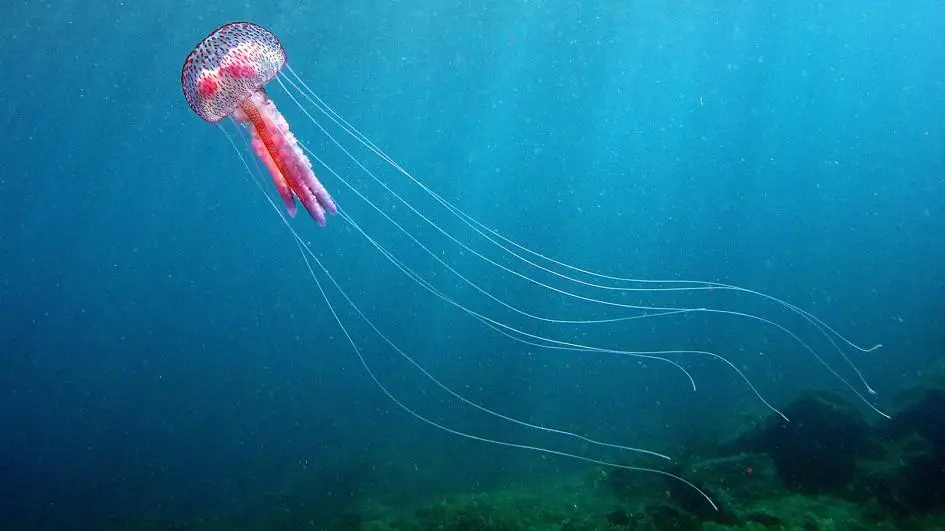How Long Does Immortal Jellyfish Live

Introduction
How Long Does Immortal Jellyfish Live: The Jellyfish live, scientifically known as Turritopsis dohrnii, is a creature that has captivated the scientific community and intrigued nature enthusiasts worldwide due to its extraordinary ability to seemingly defy the conventional laws of aging and mortality. This tiny, transparent jellyfish, found in various oceans around the world, has become the subject of intense research and fascination.
At first glance, the Immortal Jellyfish appears like any other jellyfish species, drifting gracefully through the ocean currents. However, what sets it apart is its astonishing biological mechanism that allows it to rejuvenate and restart its life cycle when faced with adverse conditions, effectively rendering it biologically immortal. This remarkable phenomenon has earned it the nickname “the Benjamin Button of the sea.”
In this exploration, we delve into the mysterious world of the Immortal Jellyfish, aiming to unravel the secrets of its longevity and the intricacies of its life cycle. We will delve into the scientific research that has illuminated our understanding of this incredible creature, its habitat, behaviors, and the potential implications of its unique abilities on the field of aging research.
Join us on this journey to uncover the astonishing story of the Immortal Jellyfish, a creature that challenges our fundamental notions of mortality and opens up exciting avenues for scientific discovery and understanding of the natural world.

How many years can immortal jellyfish live?
The immortal jellyfish can regenerate and live forever.
The immortal jellyfish, sometimes called the Benjamin Button jellyfish, is one of the only known animals that possess full regenerative capabilities, as well as being the only species of jellyfish with an indefinite lifespan.
The Immortal Jellyfish, scientifically known as Turritopsis dohrnii, is renowned for its remarkable ability to potentially live indefinitely, hence its intriguing name. While there isn’t a precise lifespan for this mysterious creature, it can, in theory, evade death from old age altogether. Most jellyfish species have a typical life cycle that includes a medusa phase (the adult) and a polyp phase (the juvenile). However, the Immortal Jellyfish has the unique capacity to revert back to its juvenile polyp form after reaching maturity. This process, called transdifferentiation, allows it to start its life cycle anew.
The key factor influencing the potential longevity of the Immortal Jellyfish is its ability to avoid mortality due to aging. In the absence of disease, predation, or other external threats, it can theoretically cycle between its adult and juvenile forms indefinitely. This incredible feat has sparked considerable scientific interest, not only for its relevance in marine biology but also for its potential implications in the study of aging and regenerative processes, offering a captivating glimpse into the mysteries of nature’s resilience and adaptation.
Can jellyfish live for 1000 years?
Wild species can live anywhere from a few days to decades. One species in particular, dubbed the ‘Immortal Jellyfish’ (Turritopsis dohrnii) may actually live forever. This jellyfish is more likely to die at the hands (or mouth) of a turtle or fish, than from old age.
Jellyfish, including the Immortal Jellyfish (Turritopsis dohrnii), are intriguing creatures with remarkable adaptations, but it’s unlikely that any jellyfish species can live for 1000 years. While the Immortal Jellyfish can theoretically avoid death from old age by reverting to its juvenile form, there are still significant challenges to its longevity.
Firstly, jellyfish, like all organisms, are susceptible to a range of threats in their environment, including predators, disease, pollution, and changing ocean conditions. These factors can significantly impact their lifespan, making it difficult for them to reach such an extraordinary age.
Secondly, the concept of “living for 1000 years” is not well-defined for jellyfish or any other species. The Immortal Jellyfish doesn’t experience time in the same way humans do, and its ability to revert to a juvenile form is not a guarantee of invincibility.
There is limited scientific data on the precise lifespan of jellyfish in the wild, and it can vary depending on species, environmental factors, and individual circumstances. While the Immortal Jellyfish showcases an incredible capacity for rejuvenation, reaching a millennium in lifespan remains a speculative and unlikely scenario. Nonetheless, these remarkable creatures continue to challenge our understanding of the natural world and inspire scientific curiosity about the secrets of longevity and regeneration.
Are jellyfish immortal alive?
Theoretically, this process can go on indefinitely, effectively rendering the jellyfish biologically immortal, although in practice individuals can still die. In nature, most Turritopsis dohrnii are likely to succumb to predation or disease in the medusa stage without reverting to the polyp form.
Jellyfish are not truly immortal in the sense that they can live forever without any limitations or external factors influencing their lifespan. However, certain jellyfish species, notably the Turritopsis dohrnii, commonly referred to as the Immortal Jellyfish, exhibit a unique and remarkable ability to potentially avoid death from old age.
The Immortal Jellyfish achieves this by undergoing a process called transdifferentiation. When faced with adverse conditions or reaching maturity, it can revert back to its juvenile polyp form, essentially restarting its life cycle. This regeneration ability is why it earned the moniker “Immortal.” It can theoretically cycle between its adult and juvenile stages indefinitely under the right conditions.
Nevertheless, the “immortality” of jellyfish is not absolute. They are still vulnerable to various threats, including disease, predation, pollution, and environmental changes. These factors can significantly impact their lifespan and survival. Moreover, scientific research on jellyfish lifespan is ongoing, and there is limited data available on their exact longevity in the wild.
While jellyfish, specifically the Immortal Jellyfish, possess extraordinary regenerative capabilities that challenge our understanding of aging, they are not truly immortal, as they remain subject to external factors that can influence their lifespan and overall survival.
How does the immortal jellyfish live forever?
When the medusa the immortal jellyfish (Turritopsis dohrnii) dies, it sinks to the ocean floor and begins to decay. Amazingly, its cells then reaggregate, not into a new medusa, but into polyps, and from these polyps emerge new jellyfish. The jellyfish has skipped to an earlier life stage to begin again.
The Immortal Jellyfish, scientifically known as Turritopsis dohrnii, has gained notoriety in the scientific world for its remarkable ability to seemingly defy the natural process of aging and live potentially indefinitely. This extraordinary feat is made possible through a fascinating biological mechanism.
At the heart of the Immortal Jellyfish’s longevity lies a process called transdifferentiation. When faced with adverse conditions, physical damage, or simply when it reaches maturity, this jellyfish has the ability to reverse its life cycle. Instead of succumbing to old age and deterioration, it reverts back to its juvenile polyp stage. This remarkable transformation allows it to start its life cycle anew.
During transdifferentiation, specialized cells in the jellyfish’s body can transform into different cell types, effectively reversing the aging process and regenerating damaged or aging tissues. This biological “reset” is why it has earned the name “Immortal.”
While the concept of immortality in the Immortal Jellyfish is captivating, it is important to note that this remarkable ability does not make it invincible. It can still fall victim to diseases, predation, pollution, and changing environmental conditions. Nevertheless, the Immortal Jellyfish’s unique capacity for regeneration continues to inspire scientific inquiry and holds the potential to shed light on the mysteries of aging and regeneration in the natural world.
How can immortal jellyfish live forever?
It has been dubbed the immortal jellyfish. When the medusa of this species is physically damaged or experiences stresses such as starvation, instead of dying it shrinks in on itself, reabsorbing its tentacles and losing the ability to swim. It then settles on the seafloor as a blob-like cyst.
The Immortal Jellyfish, scientifically known as Turritopsis dohrnii, has earned its intriguing name due to its extraordinary ability to potentially live indefinitely, effectively defying the conventional limits of mortality. This remarkable feat can be attributed to its unique biological mechanism.
The key to the Immortal Jellyfish’s potential longevity lies in its ability to undergo a process called transdifferentiation. When faced with adverse conditions or reaching the end of its natural life cycle, this jellyfish has the remarkable capability to reverse its aging process. Instead of succumbing to old age, it transforms back into its juvenile polyp stage, essentially hitting the reset button on its life cycle.
During transdifferentiation, specific cells within its body can change into different cell types, allowing for the regeneration of damaged or aging tissues. This biological “reset” is what allows the jellyfish to seemingly live forever, as it can perpetually cycle between its adult and juvenile forms.
However, it’s essential to understand that while the Immortal Jellyfish possesses this unique ability, it is not invincible. It still faces threats like predation, disease, pollution, and changing environmental conditions, which can impact its overall lifespan and survival. Nevertheless, the Immortal Jellyfish continues to captivate the scientific community, offering insights into the fascinating world of regeneration and the potential for extending the boundaries of life.
How can I learn more about Immortal Jellyfish?
If you’re eager to delve deeper into the fascinating world of the Immortal Jellyfish and learn more about this remarkable creature, there are several avenues you can explore:
- Scientific Literature: Scientific journals and articles provide in-depth information about the Immortal Jellyfish. You can access studies on its biology, behavior, and regenerative capabilities. Websites like Google Scholar and academic databases like PubMed are excellent resources for finding relevant research.
- Books: Many books on marine biology and marine life include sections or chapters dedicated to the Immortal Jellyfish. Look for titles that focus on jellyfish or marine organisms to gain a comprehensive understanding.
- Online Resources: Numerous websites, both educational and scientific, offer articles, videos, and interactive content about the Immortal Jellyfish. Institutions such as marine biology research centers or aquariums often have informative webpages.
- Documentaries: Nature documentaries frequently feature segments on unique marine creatures, including the Immortal Jellyfish. Platforms like Netflix, National Geographic, and BBC Earth often produce documentaries that showcase the wonders of the ocean.
- Aquariums and Marine Centers: Visiting a local aquarium or marine research center can provide an opportunity to see Immortal Jellyfish up close and learn from experts. These institutions often host educational programs and exhibitions about marine life.
- Online Courses: Consider enrolling in online courses related to marine biology or marine ecology. Platforms like Coursera and edX offer courses that cover various aspects of marine life, including the Immortal Jellyfish.
By exploring these resources, you can deepen your knowledge and appreciation for the Immortal Jellyfish and gain insights into the intriguing world of marine biology and biodiversity.
Are there any potential applications of the Immortal Jellyfish’s unique abilities in medical research?
The Immortal Jellyfish, Turritopsis dohrnii, possesses an extraordinary ability to revert to its juvenile form after reaching maturity, a process known as transdifferentiation. This remarkable trait has sparked keen interest in the field of medical research, offering tantalizing potential applications. One avenue of exploration lies in the realm of regenerative medicine. By deciphering the genetic and biochemical cues that trigger transdifferentiation, scientists hope to unlock similar regenerative capabilities in human cells. This could revolutionize tissue repair and regeneration, potentially leading to groundbreaking treatments for injuries, organ damage, and age-related ailments.
The Immortal Jellyfish’s unique biological process could shed light on aging-related studies. Understanding the mechanisms that allow this species to bypass the conventional aging process may hold vital clues for extending human lifespan and mitigating age-related diseases. Additionally, the jellyfish’s ability to thrive in a range of environments, including polluted or oxygen-deprived waters, raises the possibility of uncovering novel adaptations for coping with environmental stressors, which could have implications for human health in the face of changing global conditions.
In essence, the Immortal Jellyfish’s exceptional abilities open avenues of research with far-reaching implications for human well-being. The lessons gleaned from this enigmatic creature have the potential to reshape the landscape of regenerative medicine and longevity studies, offering hope for a healthier and more resilient future.
What triggers the rejuvenation process in Immortal Jellyfish?
The Immortal Jellyfish, scientifically known as Turritopsis dohrnii, possesses a biological phenomenon that has captivated scientists worldwide: its ability to revert back to its juvenile form after reaching maturity, effectively restarting its life cycle. This process, known as transdifferentiation, is triggered by environmental cues or stressors. When faced with adverse conditions such as starvation, physical damage, or changes in temperature, the adult jellyfish undergoes a remarkable transformation. It begins by retracting its tentacles and condensing its body into a gel-like mass. From this state, it then forms a protective cyst and undergoes cellular reprogramming.
Within the safety of this cyst, the jellyfish’s cells de-differentiate, effectively regressing to a more primitive state. This allows them to give rise to a new polyp, the earliest stage of the jellyfish’s life cycle. This extraordinary process grants the Immortal Jellyfish a renewed lease on life, circumventing the inevitability of aging and death.
Understanding the mechanisms that underlie this rejuvenation process holds significant promise for areas like regenerative medicine and aging research. Scientists are closely studying the genetic and biochemical triggers that initiate transdifferentiation in the hope of unlocking similar potential in human cells, offering tantalizing prospects for extending and improving the quality of human life. The Immortal Jellyfish stands as a testament to the awe-inspiring complexity and adaptability of life forms in the natural world.

Conclusion
In the realm of marine biology, the Immortal Jellyfish stands as a testament to the boundless wonders of the natural world. Its ability to evade the clutches of aging and mortality has left scientists and enthusiasts alike in awe, fostering a deeper appreciation for the intricacies of life beneath the waves.
Our journey into the realm of Turritopsis dohrnii has revealed the underlying mechanisms that enable it to achieve its “immortality.” Through cellular transdifferentiation, this enigmatic creature can revert to its juvenile stage, essentially hitting the rewind button on its life cycle, allowing it to persist indefinitely under the right conditions.
Beyond its scientific significance, the Immortal Jellyfish carries profound implications for our understanding of aging and regeneration. The insights gained from studying this unique organism may one day contribute to breakthroughs in the field of human longevity and regenerative medicine.
As we conclude our exploration, we are left with a sense of wonder and a reminder of the countless mysteries that continue to unravel in the natural world. The Immortal Jellyfish serves as a symbol of the ever-evolving, intricate tapestry of life on Earth, inviting us to remain curious and open to the limitless possibilities that nature has yet to unveil.



